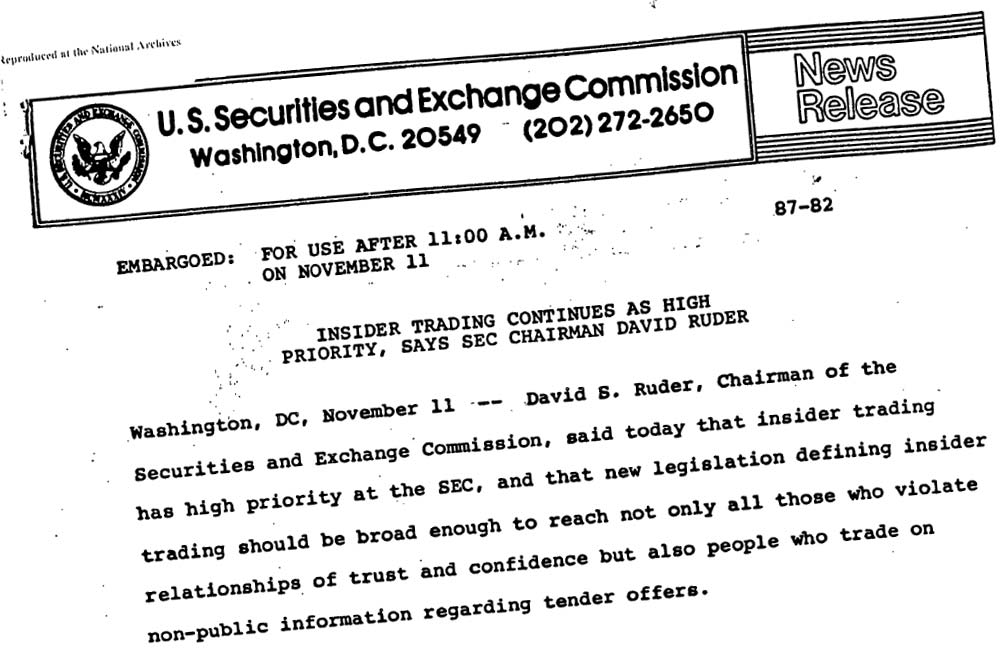


Insider trading declined as an issue at the end of the 1980s, as news of Milken’s and Drexel’s downfall combined with a takeover bust to make insider trading more risky and less profitable. The campaign against insider trading, though, had given a new boost to the SEC’s public image. It was one of the hot stories of the 1980s, even inspiring a Hollywood blockbuster, Wall Street, and the attention served, at least for a time, to give a enforcement work a bit of glamour. One Enforcement attorney recalled going to the airport in the mid-1980s and using an SEC credit card to buy a ticket on the shuttle, only to have the ticket agent respond “‘oh, you’re one of those guys?’ And that wouldn’t have happened two--three years before.”(1) The image did not always match the reality – as another SEC attorney said, “Gee, I wish it was as glamorous and exciting as it sounds”(2) – but it served to restore morale and keep the Enforcement Division one of the most popular places for young lawyers to work in the Federal government.
The publicity also ensured renewed support for the Division. As insider trading became a major issue, Congress increased the Commission’s budget, earmarking much of the money for enforcement.(3) By the early 1990s, the Division would employ 781 people, far more than twenty years before.(4) Congress also gave the SEC new powers that would have a profound impact over the next thirty years. In 1988 it passed the Insider Trading and Securities Fraud Enforcement Act, which imposed liability on some control persons and created a private right of action for illegal insider trading or tipping. More important was the Securities Enforcement Remedies and Penny Stock Reform Act of 1990: the “Remedies Act.” It built on the 1984 Insider Trading Sanctions Act by giving the Commission new powers to impose civil monetary penalties for a range of securities laws violations, to issue cease-and-desist orders, and to ask a federal court to bar an individual from serving as an officer or director of a public company.(5) A decade after a new administration had threatened to gut the Enforcement Division, it emerged with an unsurpassed public image and unprecedented new powers.
(1) John Sturc oral history: 16.
(3) Stan Hinden, SEC Seeks Big Boost in Budget; Funds would beef up Enforcement Division, Wash. Post Dec. 6, 1986: D9.
(4) Atkins & Bondi, Evaluating the Mission: 371.
(5) Seligman 618; Ralph C. Ferrara, Thomas A. Ferrigno, and David S. Darland, Hardball! The SEC’s New Arsenal of Enforcement Weapons, 47 Bus. Law. 33 (1991).
(Courtesy of the Library of Congress)
(Courtesy of Carrie E. Dwyer)
Thomas Newkirk spent 19 years -- from 1986 – 2004 -- in the SEC’s Enforcement Division. As Chief Litigation Counsel, he directed the Commission’s litigation against Drexel Burnham Lambert and Michael Milken, First Jersey and Eddie Antar (“Crazy Eddie”), and many emergency relief cases to freeze the proceeds of insider trading and halt on-going frauds. Then as an Associate Director, he led the investigations of significant financial fraud cases (Royal Ahold, PNC Financial Services Group, Tyco, Arthur Anderson, Waste Management), mutual fund cases (The Dreyfus Corporation, Kemper Financial Services), and broker-dealer cases (Prudential Securities, Gruntal & Company).